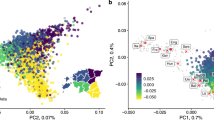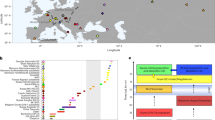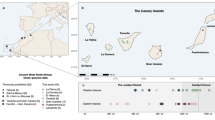Abstract
Modern humans arrived in Europe ~45,000 years ago, but little is known about their genetic composition before the start of farming ~8,500 years ago. Here we analyse genome-wide data from 51 Eurasians from ~45,000–7,000 years ago. Over this time, the proportion of Neanderthal DNA decreased from 3–6% to around 2%, consistent with natural selection against Neanderthal variants in modern humans. Whereas there is no evidence of the earliest modern humans in Europe contributing to the genetic composition of present-day Europeans, all individuals between ~37,000 and ~14,000 years ago descended from a single founder population which forms part of the ancestry of present-day Europeans. An ~35,000-year-old individual from northwest Europe represents an early branch of this founder population which was then displaced across a broad region, before reappearing in southwest Europe at the height of the last Ice Age ~19,000 years ago. During the major warming period after ~14,000 years ago, a genetic component related to present-day Near Easterners became widespread in Europe. These results document how population turnover and migration have been recurring themes of European prehistory.
This is a preview of subscription content, access via your institution
Access options
Subscribe to this journal
Receive 51 print issues and online access
$199.00 per year
only $3.90 per issue
Buy this article
- Purchase on Springer Link
- Instant access to full article PDF
Prices may be subject to local taxes which are calculated during checkout




Similar content being viewed by others
Accession codes
Primary accessions
European Nucleotide Archive
Data deposits
The aligned sequences are available through the European Nucleotide Archive under accession number PRJEB13123.
References
Gamble, C., Davies, W., Pettitt, P. & Richards, M. Climate change and evolving human diversity in Europe during the last glacial. Philosoph. Trans. Royal Soc. B 359, 243–253 (2004)
Jones, E. R. et al. Upper Palaeolithic genomes reveal deep roots of modern Eurasians. Nature Commun. 6, 8912 (2015)
Fu, Q. et al. An early modern human from Romania with a recent Neanderthal ancestor. Nature 524, 216–219 (2015)
Seguin-Orlando, A. et al. Paleogenomics. Genomic structure in Europeans dating back at least 36,200 years. Science 346, 1113–1118 (2014)
Dabney, J. et al. Complete mitochondrial genome sequence of a Middle Pleistocene cave bear reconstructed from ultrashort DNA fragments. Proc. Natl Acad. Sci. USA 110, 15758–15763 (2013)
Meyer, M. & Kircher, M. Illumina sequencing library preparation for highly multiplexed target capture and sequencing. Cold Spring Harbor Protocols 2010, pdb.prot5448 (2010)
Meyer, M. et al. A high-coverage genome sequence from an archaic Denisovan individual. Science 338, 222–226 (2012)
Rohland, N., Harney, E., Mallick, S., Nordenfelt, S. & Reich, D. Partial uracil-DNA-glycosylase treatment for screening of ancient DNA. Phil. Trans. R. Soc. Lond. B 370, 20130624 (2015)
Haak, W. et al. Massive migration from the steppe was a source for Indo-European languages in Europe. Nature 522, 207–211 (2015)
Korneliussen, T. S., Albrechtsen, A. & Nielsen, R. ANGSD: analysis of next generation sequencing data. BMC Bioinformatics 15, 356 (2014)
Krause, J. et al. A complete mtDNA genome of an early modern human from Kostenki, Russia. Curr. Biol. 20, 231–236 (2010)
Skoglund, P. et al. Origins and genetic legacy of Neolithic farmers and hunter-gatherers in Europe. Science 336, 466–469 (2012)
Fu, Q. et al. Genome sequence of a 45,000-year-old modern human from western Siberia. Nature 514, 445–449 (2014)
Raghavan, M. et al. Upper Palaeolithic Siberian genome reveals dual ancestry of Native Americans. Nature 505, 87–91 (2014)
Lazaridis, I. et al. Ancient human genomes suggest three ancestral populations for present-day Europeans. Nature 513, 409–413 (2014)
Olalde, I. et al. Derived immune and ancestral pigmentation alleles in a 7,000-year-old Mesolithic European. Nature 507, 225–228 (2014)
Gamba, C. et al. Genome flux and stasis in a five millennium transect of European prehistory. Nature Commun. 5, 5257 (2014)
Green, R. E. et al. A draft sequence of the Neandertal genome. Science 328, 710–722 (2010)
Prüfer, K. et al. The complete genome sequence of a Neanderthal from the Altai Mountains. Nature 505, 43–49 (2014)
Mallick, S. et al. The landscape of human genome diversity. Nature (in the press)
Reich, D. et al. Genetic history of an archaic hominin group from Denisova Cave in Siberia. Nature 468, 1053–1060 (2010)
Sankararaman, S. et al. The genomic landscape of Neanderthal ancestry in present-day humans. Nature 507, 354–357 (2014)
Vernot, B. & Akey, J. M. Resurrecting surviving Neandertal lineages from modern human genomes. Science 343, 1017–1021 (2014)
Harris, K. & Nielsen, R. The genetic cost of Neanderthal introgression. Genetics http://dx.doi.org/10.1534/genetics.116.186890 (2016)
Juric, I., Aeschbacher, S. & Coop, G. The strength of selection against Neanderthal introgression. Preprint at http://dx.doi.org/10.1101/030148 (2015)
Posth, C. et al. Pleistocene mitochondrial genomes suggest a single major dispersal of Non-Africans and a Late Glacial population turnover in Europe. Curr. Biol. 26, 827–833 (2016)
Olivieri, A. et al. The mtDNA legacy of the Levantine early Upper Palaeolithic in Africa. Science 314, 1767–1770 (2006)
Patterson, N. et al. Ancient admixture in human history. Genetics 192, 1065–1093 (2012)
Alexander, D. H., Novembre, J. & Lange, K. Fast model-based estimation of ancestry in unrelated individuals. Genome Res. 19, 1655–1664 (2009)
Skotte, L., Korneliussen, T. S. & Albrechtsen, A. Estimating individual admixture proportions from next generation sequencing data. Genetics 195, 693–702 (2013)
Conard, N. J. A female figurine from the basal Aurignacian of Hohle Fels Cave in southwestern Germany. Nature 459, 248–252 (2009)
Straus, L. G. After the deep freeze: confronting “Magdalenian” realities in Cantabrian Spain and beyond. J. Archaeol. Method Theory 20, 236–255 (2013)
Weaver, A. J., Saenko, O. A., Clark, P. U. & Mitrovica, J. X. Meltwater pulse 1A from Antarctica as a trigger of the Bølling-Allerød warm interval. Science 299, 1709–1713 (2003)
Montoya, C. & Peresani, M. Nouveaux éléments de diachronie dans l’Epigravettien récent des Préalpes de la Vénétie in D’un monde à l’autre. Les systèmes lithiques pendant le Tardiglaciaire autour de la Méditerranée nord-occidentale (eds Bracco, J.-P. & Montoya, C. ) 123–138 (Mémoire Société Préhistorique Française, 2005)
Valentin, B. Jalons pour une paléohistoire des derniers chasseurs (XIVe-VIe millénaires av. J.-C.) (Cahiers archéologiques de Paris 1 – 1, Publications de la Sorbonne, 2008)
Pala, M. et al. Mitochondrial DNA signals of late glacial recolonization of Europe from near eastern refugia. Am. J. Hum. Genet. 90, 915–924 (2012)
Rougier, H. et al. Peştera cu Oase 2 and the cranial morphology of early modern Europeans. Proc. Natl Acad. Sci. USA 104, 1165–1170 (2007)
Marom, A., McCullagh, J. S. O., Higham, T. F. G., Sinitsyn, A. A. & Hedges, R. E. M. Single amino acid radiocarbon dating of Upper Paleolithic modern humans. Proc. Natl Acad. Sci. USA 109, 6878–6881 (2012)
Soficaru, A., Doboş, A. & Trinkaus, E. Early modern humans from the Peştera Muierii, Baia de Fier, Romania. Proc. Natl Acad. Sci. USA 103, 17196–17201 (2006)
Palma di Cesnola, A. Paglicci. L’Aurignaziano e il Gravettiano antico (Claudio Grenzi, 2004)
Soficaru, A., Petrea, C., Doboş, A. & Trinkaus, E. The human cranium from the Peştera Cioclovina Uscată, Romania — context, age, taphonomy, morphology, and paleopathology. Curr. Anthropol. 48, 611–619 (2007)
Sinitsyn, A. A. Les sépultures de Kostenki: chronologie, attribution culturelle, rite funéraire in La spiritualité ( Otte M. (ed.)), Proceedings of UISPP conference, Liège, ERAUL 106, 237–244 (2004)
Simon, U., Haendel, M., Einwoegerer, T. & Neugebauer-Maresch, C. The archaeological record of the Gravettian open air site Krems-Wachtberg. Quat. Int. 351, 5–13 (2014)
Trinkaus, E. & Svoboda, J. Early Modern Human Evolution in Central Europe: The People of Dolní Vstonice and Pavlov, Vol. 12 (Oxford Univ. Press, 2006)
Azzi, C. M., Bigliocca, L. & Piovan, F. Florence radiocarbon dates II. Radiocarbon 16, 10–14 (1974)
Cupillard, C. et al. Changes in ecosystems, climate and societies in the Jura Mountains between 40 and 8 ka cal BP. Quat. Int. 378, 40–72 (2015)
Housley, R. A., Gamble, C. S., Street, M. & Pettitt, P. B. Radiocarbon evidence for the Lateglacial human recolonisation of Northern Europe. Proc. Prehist. Soc. 63, 25–54 (1997)
Benazzi, S. et al. Early dispersal of modern humans in Europe and implications for Neanderthal behaviour. Nature 479, 525–528 10.1038/nature10617 (2011)
Simon, U. Die Burkhardtshöhle — eine Magdalénienstation am Nordrand der Schwäbischen Alb, Magisterarbeit (1993)
Vercellotti, G., Alciati, G., Richards, M. P. & Formicola, V. The Late Upper Paleolithic skeleton Villabruna 1 (Italy): a source of data on biology and behavior of a 14.000 year-old hunter. J. Anthropol. Sci. 86, 143–163 (2008)
Drucker, D. G., Bridault, A., Cupillard, C., Hujic, A. & Bocherens, H. Evolution of habitat and environment of red deer (Cervus elaphus) during the Late-glacial and early Holocene in eastern France (French Jura and the western Alps) using multi-isotope analysis (δ13C, δ15N, δ18O, δ34S) of archaeological remains. Quat. Int. 245, 268–278 (2011)
Valentin, F. et al. Découvertes récentes d’inhumations et d’une incinération datées du Mésolithique en Île-de-France. Revue Archéologique d’Île-de-France 1, 21–42 (2008)
Bramanti, B. et al. Genetic discontinuity between local hunter-gatherers and central Europe’s first farmers. Science 326, 137–140 (2009)
Price, T. D. & Jacobs, K. Olenii Ostrov — first radiocarbon dates from a major mesolithic cemetery Karelia, USSR. Antiquity 64, 849–853 (1990)
Wehrberger, K. “Der Streit ward definitiv beendet...” Eine mesolithische Bestattung aus der Bocksteinhöhle im Lonetal, Alb-Donau-Kreis. Zur Erinnerung an Ludwig Bürger (1844–1898). Archäologisches Korrespondenzblatt 30, 15–31 (2000)
Orschiedt, J. Manipulationen an menschlichen Skelettresten. Taphonomische Prozesse, Sekundärbestattungen oder Kannibalismus. Dissertation. Urgeschichtliche Materialhefte 13 (1999)
Sánchez-Quinto, F. et al. Genomic affinities of two 7,000-year-old Iberian hunter-gatherers. Curr. Biol. 22, 1494–1499 (2012)
Reimer, P. J. et al. IntCal13 and marine13 radiocarbon age calibration curves 0–50,000 years cal bp. Radiocarbon 55, 1869–1887 (2013)
Ramsey, C. B. & Lee, S. Recent and planned developments of the program OxCal. Radiocarbon 55, 720–730 (2013)
Enattah, N. S. et al. Identification of a variant associated with adult-type hypolactasia. Nature Genet. 30, 233–237 (2002)
Bersaglieri, T. et al. Genetic signatures of strong recent positive selection at the lactase gene. Am. J. Hum. Genet. 74, 1111–1120 (2004)
Fujimoto, A. et al. A scan for genetic determinants of human hair morphology: EDAR is associated with Asian hair thickness. Hum. Mol. Genet. 17, 835–843 (2008)
Kimura, R. et al. A common variation in EDAR is a genetic determinant of shovel-shaped incisors. Am. J. Hum. Genet. 85, 528–535 (2009)
Sturm, R. A. et al. A single SNP in an evolutionary conserved region within intron 86 of the HERC2 gene determines human blue-brown eye color. Am. J. Hum. Genet. 82, 424–431 (2008)
Eiberg, H. et al. Blue eye color in humans may be caused by a perfectly associated founder mutation in a regulatory element located within the HERC2 gene inhibiting OCA2 expression. Hum. Genet. 123, 177–187 (2008)
Acknowledgements
We thank B. Alex, D. Meltzer, P. Moorjani, I. Olalde, S. Sankararaman and B. Viola for comments, K. Stewardson and E. Harney for sample screening, and F. Hallgren for sharing a radiocarbon date for Motala12. The Fig. 1 map is plotted using data available under the Open Database License © OpenStreetMap (http://www.openstreetmap.org/copyright). The Goyet project led by H.R. was funded by the Wenner-Gren Foundation (Gr. 7837), the College of Social and Behavioral Sciences of CSUN, the CSUN Competition for Research, Scholarship and Creative Activity Awards, and the RBINS. The excavation of the El Mirón Cave burial, led by L.G.S. and M.R.G.M., was supported by the Gobierno de Cantabria, the L.S.B. Leakey Foundation, the University of New Mexico, the Stone Age Research Fund (J. and R. Auel, principal donors), the town of Ramales de la Victoria and the Universidad de Cantabria. Excavations at Grotta Paglicci were performed by A. Palma di Cesnola in collaboration with the Soprintendenza Archeologia della Puglia (founded by MIUR and local Institutions). Research at Riparo Villabruna was supported by MIBACT and the Veneto Region. Q.F. was funded by the Special Foundation of the President of the Chinese Academy of Sciences (2015–2016), the Bureau of International Cooperation of the Chinese Academy of Sciences, the Chinese Academy of Sciences (XDA05130202), the National Natural Science Foundation of China (L1524016) and the Chinese Academy of Sciences Discipline Development Strategy Project (2015-DX-C-03). D.Fe was supported by an Irish Research Council grant (GOIPG/2013/36). I.M. was supported by a long-term fellowship from the Human Frontier Science Program LT001095/2014-L. P.Sk was supported by the Swedish Research Council (VR 2014-453). S.T., and M.P.R. were funded by the Max Planck Society. C.N.-M. was funded by FWF P-17258, P-19347, P-21660 and P-23612. S.C. and O.T.M. were funded by a ‘Karsthives’ Grant PCCE 31/2010 (CNCS-UEFISCDI, Romania). A.P.D., N.D., V.Sla and N.D. were funded by the Russian Science Foundation (project No.14-50-00036). M.A.M. was funded by a Marie Curie Intra-European Fellowship within the 7th European Community Framework Programme (grant number PIEF-GA-2008-219965). M.La and D.C. were funded by grants PRIN 2010-11 and 2010EL8TXP_003. C.C. and the research about the French Jura sites of Rochedane, Rigney and Ranchot was funded by the Collective Research Program (PCR) (2005-2008). K.H. was supported by the European Research Council (ERC StG 283503) and the Deutsche Forschungsgemeinschaft (DFG INST37/706-1FUGG, DFG FOR2237). D.G.D. was funded by the European Social Fund and Ministry of Science, Research and Arts of Baden-Württemberg. R.P. was funded by ERC starting grant ADNABIOARC (263441). J.Ke was funded by a grant from the Deutsche Forschungsgemeinschaft (SFB1052, project A02). J.Kr was funded by DFG grant KR 4015/1-1, the Baden Württemberg Foundation, and the Max Planck Society. S.P. were funded by the Max Planck Society and the Krekeler Foundation. D.R. was funded by NSF HOMINID grant BCS-1032255, NIH (NIGMS) grant GM100233, and the Howard Hughes Medical Institute.
Author information
Authors and Affiliations
Contributions
J.Kr, S.P. and D.R. conceived the idea for the study. Q.F., C.P., M.H., W.H., M.Me, V.Slo, R.G.C., A.P.D., N.D., V.Sla, A.T., F.M., B.G., E.V., M.R.G.M., L.G.S., C.N.-M., M.T.-N., S.C., O.T.M., S.B., M.Per, D.Co, M.La, S.R., A.R., F.V., C.T., K.W., D.G., H.R., I.C., D.Fl, P.Se, M.A.M., C.C., H.B., N.J.C., K.H., V.M., D.G.D., J.S., D.Ca, R.P., J.Kr, S.P. and D.R. assembled archaeological material. Q.F., C.P., M.H., D.Fe, A.F., W.H., M.Me, A.M., B.N., N.R., V.Slo, S.T., H.B., D.G.D., M.P.R., R.P., J.Kr, S.P. and D.R. performed or supervised wet laboratory work. Q.F., C.P., M.H., M.Pet, S.M., A.P., I.L., M.Li, I.M., S.S., P.Sk, J.Ke, N.P. and D.R. analysed data. Q.F., C.P., M.H., M.Pet, J.Ke, S.P. and D.R. wrote the manuscript and supplements.
Corresponding author
Ethics declarations
Competing interests
The authors declare no competing financial interests.
Additional information
Reviewer Information Nature thanks C. Lalueza-Fox and the other anonymous reviewer(s) for their contribution to the peer review of this work.
Extended data figures and tables
Extended Data Figure 1 A decrease in Neanderthal ancestry in the last 45,000 years.
This is similar to Fig. 2, except we use ancestry estimates from rates of alleles matching to Neanderthal rather than f4-ratios, as described in Supplementary Information section 3. The least-squares fit excludes Oase1 (as an outlier with recent Neanderthal ancestry) and Europeans (known to have reduced Neanderthal ancestry). The regression slope is significantly negative (P = 0.00004, Extended Data Table 3).
Extended Data Figure 2 Heat matrix of pairwise f3(X, Y; Mbuti) for selected ancient individuals.
Only individuals with at least 30,000 SNPs covered at least once are analysed.
Extended Data Figure 3 Studying how the relatedness of non-European populations to pairs of European hunter-gatherers changes over time.
Statistics were examined of the form D(W, X; Y, Mbuti), with the Z-score given on the y axis, where W is an early European hunter-gatherer, X is another European hunter-gatherer (in chronological order on the x axis), and Y is a non-European population (see legend). a, W = Kostenki14. b, W = GoyetQ116-1. c, W = Vestonice16. d, W = ElMiron. |Z| > 3 scores are considered statistically significant (horizontal line). The similar Fig. 4b gives absolute D-statistic values rather than Z-scores (for W = Kostenki14) and uses pooled regions rather than individual populations Y.
Extended Data Figure 4 Three admixture graph models that fit the data for Satsurblia, an Upper Palaeolithic individual from the Caucasus.
These models use 127,057 SNPs covered in all populations. Estimated genetic drifts are given along the solid lines in units of f2-distance (parts per thousand), and estimated mixture proportions are given along the dotted lines. All three models provide a fit to the allele frequency correlation data among Mbuti, Ust’-Ishim, Kostenki14, Vestonice16, Malta1, ElMiron and Satsurblia to within the limits of our resolution, in the sense that all empirical f2-, f3- and f4-statistics relating the individuals are within three standard errors of the expectation of the model. Models in which Satsurblia is treated as unadmixed cannot be fit.
Supplementary information
Supplementary Information
This file contains Supplementary Text and Data, Supplementary Tables, Supplementary Figures and additional references (see Contents for more details). (PDF 8052 kb)
Rights and permissions
About this article
Cite this article
Fu, Q., Posth, C., Hajdinjak, M. et al. The genetic history of Ice Age Europe. Nature 534, 200–205 (2016). https://doi.org/10.1038/nature17993
Received:
Accepted:
Published:
Issue Date:
DOI: https://doi.org/10.1038/nature17993
This article is cited by
-
Genetic history of East-Central Europe in the first millennium CE
Genome Biology (2023)
-
Near-infrared hyperspectral imaging to map collagen content in prehistoric bones for radiocarbon dating
Communications Chemistry (2023)
-
Socio-cultural practices may have affected sex differences in stature in Early Neolithic Europe
Nature Human Behaviour (2023)
-
Ancient genomes show how humans escaped Europe’s deep freeze
Nature (2023)
-
The genomic history of ice-age Europeans
Nature (2023)
Comments
By submitting a comment you agree to abide by our Terms and Community Guidelines. If you find something abusive or that does not comply with our terms or guidelines please flag it as inappropriate.



